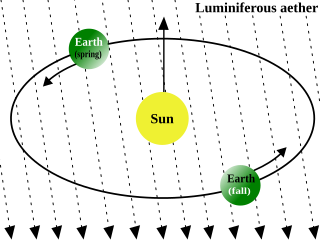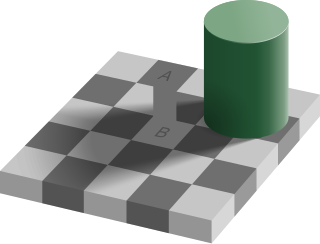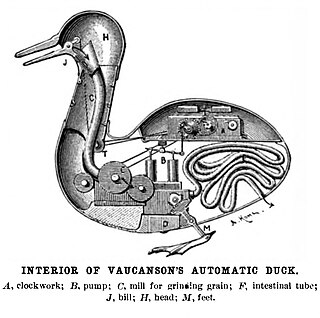In philosophy, empiricism is a theory that states that knowledge comes only or primarily from sensory experience. It is one of several views of epistemology, the study of human knowledge, along with rationalism and skepticism. Empiricism emphasises the role of empirical evidence in the formation of ideas, rather than innate ideas or traditions. However, empiricists may argue that traditions arise due to relations of previous sense experiences.

Luminiferous aether or ether was the postulated medium for the propagation of light. It was invoked to explain the ability of the apparently wave-based light to propagate through empty space, something that waves should not be able to do. The assumption of a spatial plenum of luminiferous aether, rather than a spatial vacuum, provided the theoretical medium that was required by wave theories of light.
Materialism is a form of philosophical monism that holds that matter is the fundamental substance in nature, and that all things, including mental states and consciousness, are results of material interactions. According to philosophical materialism, mind and consciousness are by-products or epiphenomena of material processes, without which they cannot exist. This concept directly contrasts with idealism, where mind and consciousness are first-order realities to which matter is subject and material interactions are secondary.

The philosophy of perception is concerned with the nature of perceptual experience and the status of perceptual data, in particular how they relate to beliefs about, or knowledge of, the world. Any explicit account of perception requires a commitment to one of a variety of ontological or metaphysical views. Philosophers distinguish internalist accounts, which assume that perceptions of objects, and knowledge or beliefs about them, are aspects of an individual's mind, and externalist accounts, which state that they constitute real aspects of the world external to the individual. The position of naïve realism—the 'everyday' impression of physical objects constituting what is perceived—is to some extent contradicted by the occurrence of perceptual illusions and hallucinations and the relativity of perceptual experience as well as certain insights in science. Realist conceptions include phenomenalism and direct and indirect realism. Anti-realist conceptions include idealism and skepticism.
The following outline is provided as an overview of and topical guide to physics:
Reality is the sum or aggregate of all that is real or existent within a system, as opposed to that which is only imaginary. The term is also used to refer to the ontological status of things, indicating their existence. In physical terms, reality is the totality of a system, known and unknown. Philosophical questions about the nature of reality or existence or being are considered under the rubric of ontology, which is a major branch of metaphysics in the Western philosophical tradition. Ontological questions also feature in diverse branches of philosophy, including the philosophy of science, philosophy of religion, philosophy of mathematics, and philosophical logic. These include questions about whether only physical objects are real, whether reality is fundamentally immaterial, whether hypothetical unobservable entities posited by scientific theories exist, whether God exists, whether numbers and other abstract objects exist, and whether possible worlds exist.

Reductionism is any of several related philosophical ideas regarding the associations between phenomena which can be described in terms of other simpler or more fundamental phenomena.
Newton's laws of motion are three physical laws that, together, laid the foundation for classical mechanics. They describe the relationship between a body and the forces acting upon it, and its motion in response to those forces. More precisely, the first law defines the force qualitatively, the second law offers a quantitative measure of the force, and the third asserts that a single isolated force doesn't exist. These three laws have been expressed in several ways, over nearly three centuries, and can be summarised as follows:
Gestalt psychology or gestaltism is a school of psychology that emerged in Austria and Germany in the early twentieth century based on work by Max Wertheimer, Wolfgang Köhler, and Kurt Koffka. As used in Gestalt psychology, the German word gestalt is interpreted as "pattern" or "configuration". Gestalt psychologists emphasized that organisms perceive entire patterns or configurations, not merely individual components. The view is sometimes summarized using the adage, "the whole is more than the sum of its parts."
In philosophy of science and in epistemology, instrumentalism is a methodological view that ideas are useful instruments, and that the worth of an idea is based on how effective it is in explaining and predicting phenomena. Instrumentalism is a pragmatic philosophy of John Dewey that thought is an instrument for solving practical problems, and that truth is not fixed but changes as problems change. Instrumentalism is the view that scientific theories are useful tools for predicting phenomena instead of true or approximately true descriptions.
Phenomenalism is the view that physical objects cannot justifiably be said to exist in themselves, but only as perceptual phenomena or sensory stimuli situated in time and in space. In particular, some forms of phenomenalism reduce talk about physical objects in the external world to talk about bundles of sense-data.

The Critique of Pure Reason is a book by the German philosopher Immanuel Kant, in which the author seeks to determine the limits and scope of metaphysics. Also referred to as Kant's "First Critique", it was followed by the Critique of Practical Reason (1788) and the Critique of Judgment (1790). In the preface to the first edition, Kant explains that by a "critique of pure reason" he means a critique "of the faculty of reason in general, in respect of all knowledge after which it may strive independently of all experience" and that he aims to reach a decision about "the possibility or impossibility of metaphysics".
The hard problem of consciousness is the problem of explaining why and how sentient organisms have qualia or phenomenal experiences—how and why it is that some internal states are felt states, such as heat or pain, rather than unfelt states, as in a thermostat or a toaster. The philosopher David Chalmers, who introduced the term "hard problem" of consciousness, contrasts this with the "easy problems" of explaining the ability to discriminate, integrate information, report mental states, focus attention, and so forth. Easy problems are (relatively) easy because all that is required for their solution is to specify a mechanism that can perform the function. That is, regardless of how complex or poorly understood the phenomena of the easy problems may be, they can eventually be understood by relying entirely on standard scientific methodologies. Chalmers claims that the problem of experience is distinct from this set and will "persist even when the performance of all the relevant functions is explained".
Philosophy of space and time is the branch of philosophy concerned with the issues surrounding the ontology, epistemology, and character of space and time. While such ideas have been central to philosophy from its inception, the philosophy of space and time was both an inspiration for and a central aspect of early analytic philosophy. The subject focuses on a number of basic issues, including whether time and space exist independently of the mind, whether they exist independently of one another, what accounts for time's apparently unidirectional flow, whether times other than the present moment exist, and questions about the nature of identity.

Absolute space and time is a concept in physics and philosophy about the properties of the universe. In physics, absolute space and time may be a preferred frame.
The deductive-nomological model, also known as Hempel's model, the Hempel–Oppenheim model, the Popper–Hempel model, or the covering law model, is a formal view of scientifically answering questions asking, "Why...?". The DN model poses scientific explanation as a deductive structure—that is, one where truth of its premises entails truth of its conclusion—hinged on accurate prediction or postdiction of the phenomenon to be explained.

The mind–body problem is a debate concerning the relationship between thought and consciousness in the human mind, and the brain as part of the physical body. It is distinct from the question of how mind and body function chemically and physiologically, as that question presupposes an interactionist account of mind–body relations. This question arises when mind and body are considered as distinct, based on the premise that the mind and the body are fundamentally different in nature.
The natural sciences saw various advancements during the Golden Age of Islam, adding a number of innovations to the Transmission of the Classics. During this period, Islamic theology was encouraging of thinkers to find knowledge. Thinkers from this period included Al-Farabi, Abu Bishr Matta, Ibn Sina, al-Hassan Ibn al-Haytham and Ibn Bajjah. These works and the important commentaries on them were the wellspring of science during the medieval period. They were translated into Arabic, the lingua franca of this period.
The Romantics, in seeking to understand Nature in her living essence, studied the 'Father of Science', Sir Francis Bacon. The view of Bacon and the 'inductive method' that emerges is quite a different one from that that tended to prevail both before and then after, here mainly due to John Stuart Mill's interpretation later in the 1800s. For the Romantics, induction as generally interpreted 'was not enough to produce correct understanding in Bacon's terms.' They saw another side of Bacon, generally not developed, one in which nature was a labyrinth not open to "excellence of wit" nor "chance experiments": "Our steps must be guided by a clue, and see what way from the first perception of the sense must be laid out upon a sure plan."
Romanticism grew largely out of an attempt to understand not just inert nature, but also vital nature. Romantic works in the realm of art and Romantic medicine were a response to the general failure of the application of method of inertial science to reveal the foundational laws and operant principles of vital nature. German romantic science and medicine sought to understand the nature of the life principle identified by John Hunter as distinct from matter itself via Johan Friedrich Blumenbach's Bildungstrieb and Romantic medicine's Lebenskraft, as well as Röschlaub's development of the Brunonian system of medicine system of John Brown, in his excitation theory of life, working also with Schelling's Naturphilosophie, the work of Goethe regarding morphology, and the first dynamic conception of physiology of Richard Saumarez. However, it is in Samuel Taylor Coleridge that we find the question of life and vital nature most intensely and comprehensively examined, particularly in his Hints towards the Formation of a more Comprehensive Theory of Life (1818), providing the foundation for Romantic philosophy, science and medicine. The work is key to understanding the relationship of Romantic literature and science.